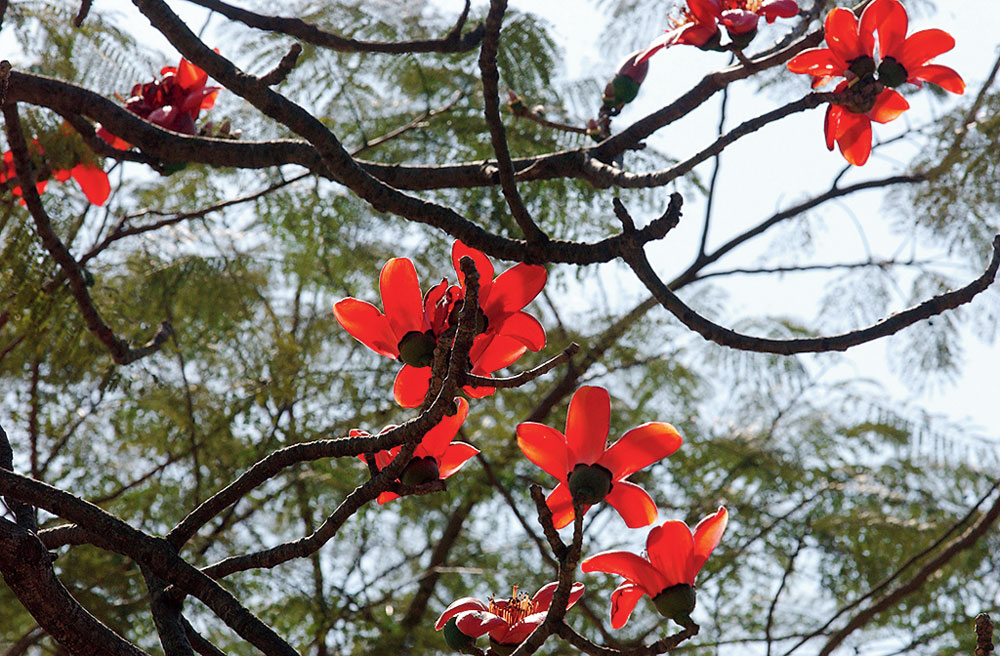There is something inherently beautiful about trees standing tall amidst the highs and lows of daily life. We may miss them but they’re there, watching over the fuming traffic, men and women going about their work, youthful faces, wooden faces, evil faces, collapsing bridges, and often the raucous chores of democracy.
Calcutta has long left winter behind and the simul, palash, jarul, tecoma and jacaranda are responding gorgeously to the early vibes of summer. “This transformation is most dramatic,” says Supatra Sen, for whom observing the boughs and blooms is but a way of life. “When I was small, I would hear someone say, ‘the rudra palash has begun to flower, which means the cold will soon vanish,’” exuberates Sen, a lecturer in Botany at a city college.
The bright reddish-orange corolla of rudra palash, or African tulip — a tall, dark and handsome tree — has indeed put up a spectacular show, with at least one player on every street or in each neighbourhood. This huge tree, which also goes by the name nandi flame, was not such a common sight a decade ago. Foliage experts in distant lands consider it to be one of the worst invaders — they say it invades natural ecosystems and crowds out native vegetation.
Saurabh Chaudhuri doesn’t think so. “The tree hasn’t got a bad reputation in India; on the contrary it is quite useful to the hummingbird, shalik and haanrichacha, which feed on the flowers, fruits and the honey, of course.” Chaudhuri, who is with the state’s forest department, also points out that rudra palash does not spread on its own. “All the trees have been planted; it is a popular species for avenue plantation.”
As its other name suggests, rudra palash has its origins in Africa. In fact, many of the showy flowering trees commonly seen in India were brought in by British colonisers, all the way from Africa. “That includes krishnachura (gulmohar), radhachura, poinsettia,” says Chaudhuri. “These were brought via the sea. To this day, a few of those planted by the side of very old roads near the ports of Calcutta and Chennai remain.”
The bounty of krishnachura and radhachura are still some time and temperature away. In the meantime, the fern-like young leaves of the flamboyant gulmohar appear to be trembling in the wind as though playing a prelude. The simul — or red silk cotton tree — however, is calling it a day, not the entire population but in phases. Its palm-size pulpy red flowers sit on bare boughs, most ostentatious against the blue sky, and if you accidentally step on a soggy one that has decided to grace the ground, you may be sent flying. A few weeks later though, the silken fibres will be seen floating in the breeze, and a few inquisitive children running after them.
“There is a fine simul on my way to college. I took a picture of it in full bloom only last week. But yesterday, when I stopped by, the flowers were all gone. There were instead a few young leaves shining in the sun,” says Nishi Pulugurtha, who has a keen eye for all things fine. And when she isn’t delivering lectures, she is busy travelling and taking notes. “VIP Road would be a riot of colours around this time. I do see a bit of violet and yellow still, but nothing like what it was earlier,” she rues. Why the colour has vanished from this stretch is, of course, anybody’s guess.

Rudra palash Picture by Subhendu Chaki
There’s a definite yearning to stand beneath the spreading branches on a sunny day in the hot weather, and look, and listen, and smell. Or at least be satisfied with the knowledge that the branches are thronged by birds, the barks by insects, and all’s well with the world.
The sight of huge flowering trees can be quite overpowering, as also the quest for such a sight. The palash — known by several names such as flame of the forest, sacred tree, bastard teak, and carrying with it as many associations — is perhaps best felt around the red soils of Birbhum and Purulia. It grows in red and yellow there; in Calcutta though the latter is rare.
“Someone had told me of a thick palash grove in Belur, near the ESI Hospital there,” says Sen, recounting her moment of flower feeling. “So one fine day, I drove in search of it, and there it was — a riot of red and yellow, thick on the branches and thick on the ground.” A Good Samaritan had planted the garden some decades ago, the fruits of which continue to gladden and cleanse. As she describes it, there is an instant change in mood; one seems to be at peace with oneself. The wise had deciphered it long, long ago as the quintessence of happiness, of beauty, plenty and animation.
And that is exactly what Jayashree Chakravarty wishes to hold on to, in the face of depletion. “In our childhood, we derived our fantasy from our natural surroundings, something that today’s generations in the big cities is missing.” Chakravarty is an artist — she fills her canvasses with dried leaves, twigs and flowers which she collects from the ground. “I know what it means to pick up a sweet-smelling chaanpa, at the break of day,” she says. “I try to recreate that feeling of comfort.”
A mood changer here. The amaltash or Indian laburnum will probably have the last word in this clamour of colours. It would do us well to beware of those bunches of shimmering gold, swinging and laughing in the 40-degree heat right next to the melting asphalt.










